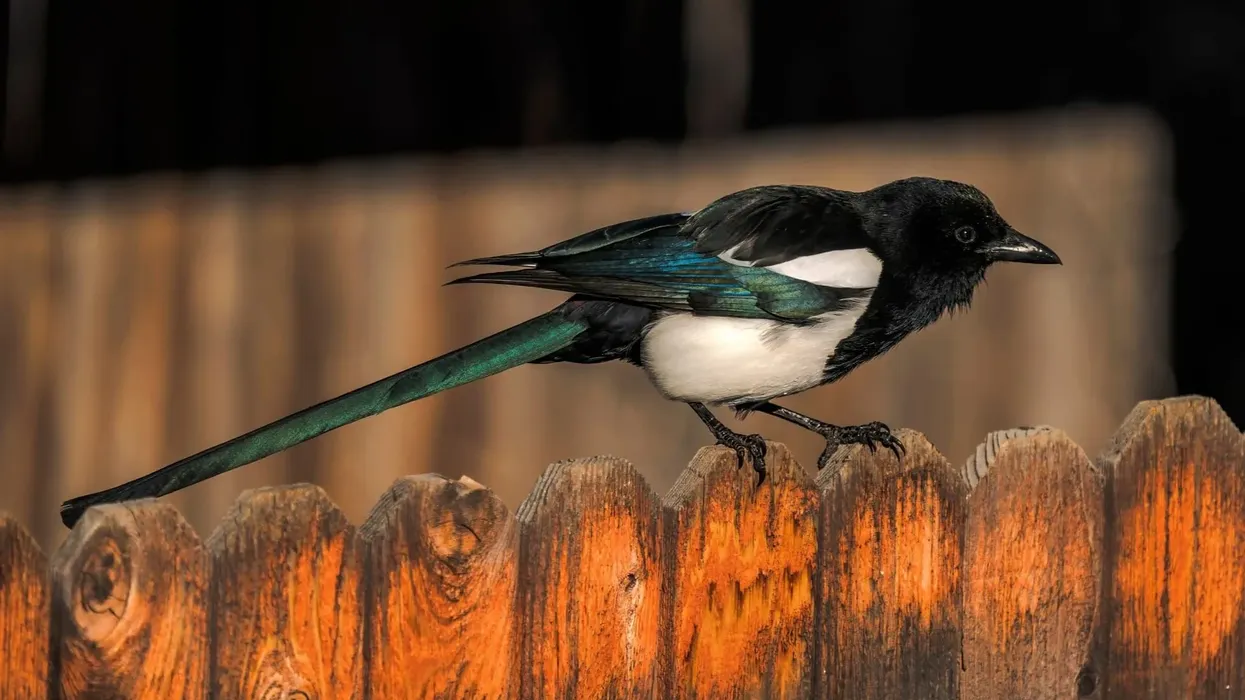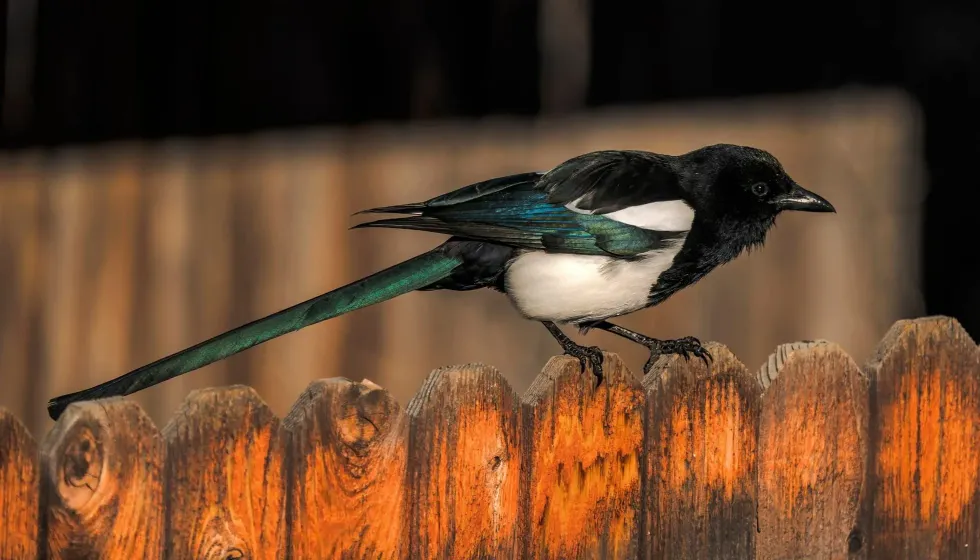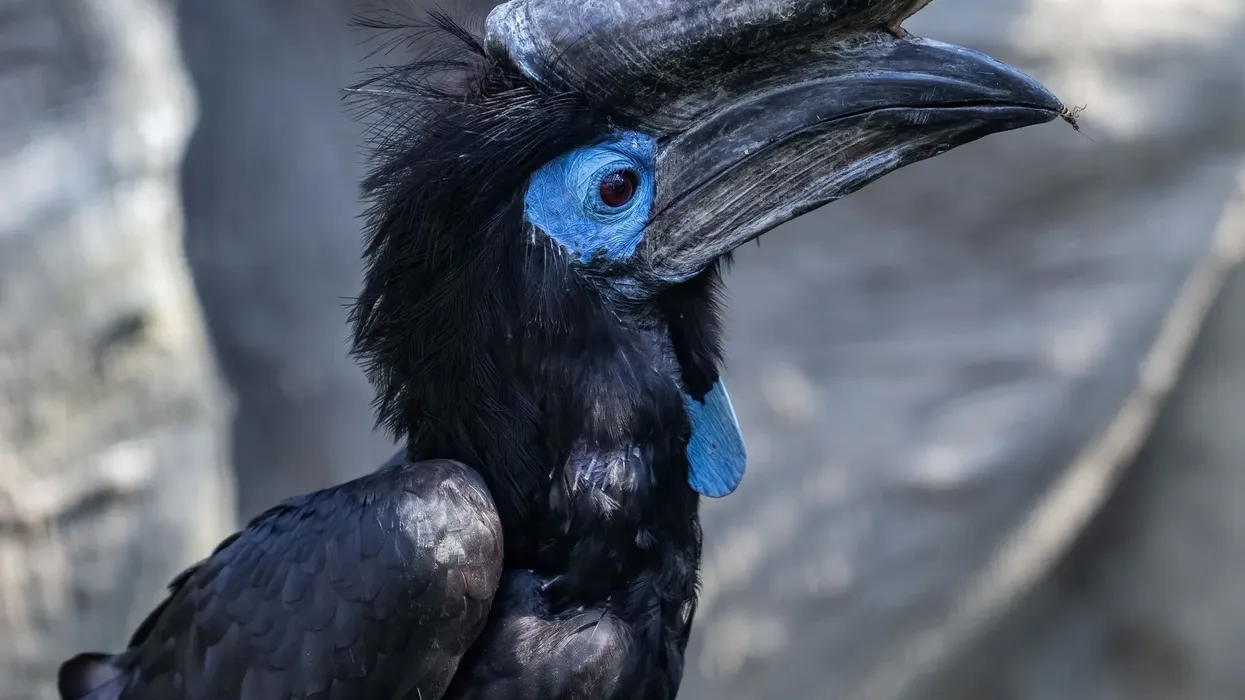Ever see a bird walking with swagger? Well, then you must have encountered the black-billed magpie as magpies walk with a swaggering strut.
The black-billed magpie, scientifically referred to as the Pica hudsonia is a small North American bird found mostly in open areas in towns or sitting on fences and lampposts. They are not found in dense forests or thickets and are mostly hunted down by ravens.
These birds have an overall black and white plumage and their conservation status is listed as not extinct.
They are commonly seen in North America and are not very rare to spot. These birds are omnivorous in nature and feed on seeds, insects, berries.
Here are some of the most interesting facts about the birds from the family of crows and jays. After reading these fascinating black-billed magpie facts, do check our other articles on common buzzard facts and king vulture facts as well.
Black-billed Magpie Interesting Facts
What type of animal is a black-billed magpie?
A black-billed magpie (Pica hudsonia) is a bird native to the West of North America or western America. The wings of these birds have patches of white which can be seen easily. They are mostly found sitting on towers or treetops. This birds species belong to the crow family.
What class of animal does a black-billed magpie belong to?
The black-billed magpie belongs to the class Aves, order Passeriformes, family Corvidae, and phylum Chordate. These birds are commonly seen in Alaska, Texas, Nevada, California, Arizona, Mexico, Kansas. Black-billed magpie sighting is a common occurrence in these regions.
How many black-billed magpies are there in the world?
An estimated number of five million black-billed magpies can be found in North America alone and some members of the species are also present in the west or western America.
The population of these birds from the crow family is stable and there isn't any immediate threat to them. Climate change and predation by ravens can cause the population of the species to decline in the long run.
As per studies, an increase in the summer climate by 3 degree celsius will lead to almost 68% reduction in the range of black-billed magpie.
Where does a black-billed magpie live?
Black-billed magpies are common can be found on tree-tops, housetops, rangelands, fence posts, and road signs. These birds do not live in thick forests like many bird similar species and are mostly seen in the open nests.
Their habitats can be found in Nevada, Arizona, New Mexico, Kansas, and Nebraska in the US and across several regions of Canada as well.
Black-billed magpies are not known to migrate but there is some upslope movement during fall, while a few individuals move southward or downslope in winter. As humans have started encroaching on their natural habitat, this bird species can also be found living in suburban areas.
What is a black-billed magpie's habitat?
Black-billed magpie habitat and nests consist of wooded regions and thickets are usually used to build nests and also to escape from predators and animals nests. These birds are mostly found near water bodies in locations where there are trees as water is important for their survival.
Shrubs that can hold the bulky nest of the black-billed magpie are also a habitat of these birds.
This species is terrestrial in nature and survives best in temperate conditions. Changes in water cycles have been known to initiate habitat shifts for these birds.
Who do black-billed magpies live with?
Black Billed magpies live in a family of 6-10 members, but larger animals and families are possible too. These birds are mostly found in pairs during the breeding season.
Birds of this species are social creatures but a black-billed magpie female is very shy in nature. A black-billed magpie nest site is usually in large trees. While the males take care of the exteriors, females take care of the interior of the 'mud-cup' shaped nest and line it with grass.
How long does a black-billed magpie live?
The average and maximum lifespan of a black-billed magpie in the wild is 4-6 years. They are mostly killed by a raven or other prey birds until they complete their total lifespan.
How do they reproduce?
The black-billed magpie achieves sexual maturity at the age of 1-2 years of age. Black-billed magpie mating season varies.
Black-billed magpies produce only a single brood in a period of 12 months followed by eggs hatching. Pre-mating ritual is commonly seen. Body displays and calls are used to attract mates.
Most black-billed magpies bond for life, but some change their mates yearly. During the breeding season, male and female magpies are seen in pairs. The breeding season starts in March and continues till June.
The average litter size of magpie is 5-6 eggs per litter and the eggs are incubated for hatching by the female magpie while the male gathers food for the female. Both the males and females take care of the young birds till they are able to fly on their own in about four weeks.
What is their conservation status?
The conservation status of black-billed magpies is listed as least concern. Their population is stable, and they can be found on a large scale in western North America. However, black-billed magpie hunting is becoming common.
Black-billed Magpie Fun Facts
What do black-billed magpies look like?
These birds of North America are mostly black and their wings have white wing patches and the black-billed magpie skull is huge. The sexes of these North American birds are similar in appearance, but males usually have a heavier body compared to females.
The bills and legs are black in color. Few patches of green or bronze can also be seen on the body but most common are white wing patches.
How cute are they?
These North American birds are not very cute. They do not have colorful plumage. Most of the body is colored in black and white. They become very noisy when they find a fruit tree or any location where the food supply is abundant.
How do they communicate?
The black-billed magpie sound and black-billed magpie call is very low-pitched. Physical displays like flashing white patches on their wings and flashing the tail are common. Raucous calls, which are high-pitched, can also be heard.
"Meeah" and "shek shek shek" are common vocalizations uttered by black-billed magpies. Females tend to produce a loud call during the mating season. A black-billed magpie song is also a communication form.
How big is a black-billed magpie?
The North American black-billed magpie height ranges as the usual body length of a black-billed magpie is 18-24 in (45.72-60.9 cm), and the typical body weight is less, between 5.9-7.6 oz (0.16 - 0.21 kg). The average weight of a North American black-billed magpie is 6.4 oz (0.18 kg).
How fast can a black-billed magpie fly?
Black-billed magpies were recorded to fly at a speed of 60 Hz. The average speed at which black-billed magpies fly is around 7 mph (11 kph). They are not fast at flying but will escape quickly and hide in thickets if approached by a raven. A black-billed magpie flying sighting is a rare occasion.
How much does a black-billed magpie weigh?
The average weight of a black-billed magpie is 6.4 oz (0.18 kg). The usual weight of this bird species is between 5.9-7.6 oz (0.16 - 0.21 kg). The male black-billed magpie usually has a heavier body as compared to females.
What are their male and female names of the species?
There are no distinctive names for the male and female species of a black-billed magpie. They are commonly known as male black-billed magpie and female black-billed magpie.
What would you call a baby black-billed magpie?
A baby black-billed magpie is called a hatchling, nestling or fledgling according to its stages of development. They do not have a specific name and are named like juveniles of all other bird species.
What do they eat?
Black-billed magpies are omnivorous in nature and eat plant and animal material. They can survive on nuts, seeds, fruits, fly maggots, larvae, meadow voles and eggs, and hatchlings of other songbirds.
They also eat debris of dead animals and hunt down rodents like mice. They forage the ground for food and usually dig small depressions in the ground during the winter season for storing food.
Are they aggressive?
No, they are generally shy and will flee from their predators and hide in thickets. They can be aggressive towards other members while feeding. Aggressive displays are also recorded during the breeding season when other males try to woo females for mating.
Would they make a good pet?
No, a black-billed magpie pet would not make a good pet as they are very social and live with their family members. They brood only once a year and have a short lifespan. They should be left in their natural environment to brood and feed and should not be caged in an apartment.
Did you know...
As the responsibilities of the male and the female black-billed magpies are equally shared after the eggs are laid, the brood will not survive if any one of the parents dies. Female black billed magpie achieve sexual maturity at the age of one, while males can reproduce sexually after they reach two years old.
Black-billed magpies try to produce a second brood if the first one is unsuccessful. They also are seen to perform a funeral ceremony by gathering around a dead black-billed magpie for some time.
The impact of black-billed magpies on bird populations remains largely unclear to this day, due to contrasting results in different research reports.
When Lewis and Clark first encountered magpies in 1804 in South Dakota, they reported the birds as being very bold, entering tents or taking food from the hand. They have the credit for introducing these bold birds into the fauna of the United States.
Who takes care of black-billed magpie young?
Both the male and female take care of the young black-billed magpies. They are fed even after they start to fly. Black-billed magpie anatomy is conducted for black-billed magpie research purposes.
What phylum is the black-billed magpie?
The phylum of the black-billed magpie is chordate.
Here at Kidadl, we have carefully created lots of interesting family-friendly animal facts for everyone to discover! For more relatable content, check out these shrike facts and American wigeon facts.
You can even occupy yourself at home by drawing one on our magpie coloring pages.









